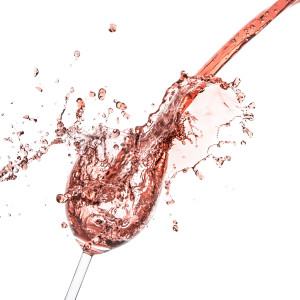For such a pretty, beautifully hued and generally cheerful-looking wine, rosé in South Africa has had a really strained relationship with consumers over the past decade or so. I’m not pointing fingers or laying blame but I suspect we’d all agree that this is largely due to two reasons: sugar and volume. I sincerely mean no offense to any producer but sugary sweet pink wines and pink wines in big boxes have – in the minds of many – set the tone for rosé consumption in SA. OBVIOUSLY not exclusively, but it’s a connotation that has been pretty dominant. Pair that perception with the idea that rosé is for girls, and you’ve essentially shoved your average rosé consumer into a pretty tightly defined box. Today though, I say to you, rejoice! For rosé is riding its own little wave of revolution – and we are all better off for it.
I may have mentioned previously my pained personal relationship with the rosy liquid; a definite case of “It’s not you, it’s me”. For years I avoided any and all wines which I even imagined had a hue of blush in it. This aversion was not because of anything wrong with rosé as such – not cultivar or style, not even sugar or bulk. It was all based on one week in 2006 where I was immersed in pink wine. As part of my honours degree, we completed a sensory training course at the Stellenbosch University Department of Food Science. The subject for that year was rosé wine. I spent a full week tasting, evaluating, studying, spitting, swirling and accidentally swallowing pink wine – from 8AM to 5PM. Five full days. The aim of the course was to teach us about the basic principles of sensory evaluation by training the group as a sensory panel. So we spent the days familiarising ourselves with the typical rosé characteristics, comparing each aroma and taste with the actual foodstuff, and then went into painfully detailed scoring processes. The wines were dead average. Dead boring. Dead awful.
I am not even moderately exaggerating when I tell you that for nearly 6 years I refused to even taste pink wines. At wine outings, I’d simply let the blush bottles pass me by. I wouldn’t even sniff it. I was traumatised. Academically the experience was fantastic. Practically, I was ruined.
Now, anyone who has ever read a word I’ve written has probably garnered that I pride myself on not being a judgmental wine drinker (or writer). Like everyone, I have my preferences, but I’ll try anything once and give all wines a fair chance to impress or inspire me. So when I ventured into the world of wine writing, I realised I could not be a credible wino if I ignore an entire style of wine. I reconciled with the pink monstrosity I’d so battled with for years and I can tell you now, I could not be happier.
Anyone who has paid a modicum of attention to what’s happening in your local wine shops will probably have noticed significant growth in contents of the pink shelves. Not only are there more rosé wines being produced, but styles are lighter, more Provençal and undoubtedly more delicious. SA has seen rosé consumption treble between 2007 and now – it is the fastest growing local wine category. And it’s not just here that the pinkies have been moving and shaking. Both USA and UK show double digit growth figures in the category and – shock! horror! – last year the richest of the rich in the New York Hamptons ran out of the precious pink nectar.
It’s a brilliant food wine (not sure if you should pair white or red with that meal? How about pink. Ding ding ding! We have a winner.). Pink MCC has also increased dramatically with winemakers exploring new styles and cultivars. And you know, the pink bubbles are often more expensive (even arguably, more delicious?) than their white counterparts.
Doubtless then that now is a terrific time to introduce SA’s first exclusive rosè wine competition. Conceptualised and brought to life by Clare Mack and her team at Spill Brand Communications, the Rosè Rocks competition was born. I was tickled pink (sorry…) to be invited to judge the competition. We were chaired by the brilliant Allan Mullins and the judging panel consisted of myself, Tinashe Nyamudoka (the head sommelier at The Test Kitchen), Neil Pendock, Malu Lambert (freelance food & wine journo) and Praisy Dlamini (winemaker at Zonnebloem). The judging went down yesterday and was completed as a blind tasting. All the results will be audited by Grant Thornton to ensure transparency and results the public can have confidence in.
We tasted around 160 odd entries and I was both impressed and slightly relieved to find that the majority of the entries were dry and off-dry. A relatively small amount of sweet pinks were entered. There were also a good amount of MCC entries (and what a treat it was to judge those). The winners will be announced at the awards ceremony on the 30th of September. As everything was tasted blind, not even the judges knows who came out tops. There will be a Top 10 announced for the still wines as well as one overall winner, and a Top 3 MCC wines and also one overall winner.
This may have been my first formal competition judging experience, but it was an excellent one. Scores were tallied, results discussed and the top wines were re-tasted to ensure that a deserving winner was picked. I’m counting the days until the embargo lifts and I can quiz the organizers about the identities of my personal favourite picks, because I will definitely be stocking up.
Most importantly, the interest in this competition has been immense, boding well for a summer of superb rosè sales and consumption alike. If you are someone who (like I was) simply does not rate rosè, I urge you to take a fresh look at what’s happening in this category. In fact, I will struggle to take you seriously as a wine drinker if you don’t at least try. And the idea that pink wines are for ladies is so last year. I’d refer you to the brosè movement and tell you that real men can pull off drinking pink drinks.
I’ll be spending my summer sipping away on some cool rosè, feeling pretty pleased to be back in the pink.


